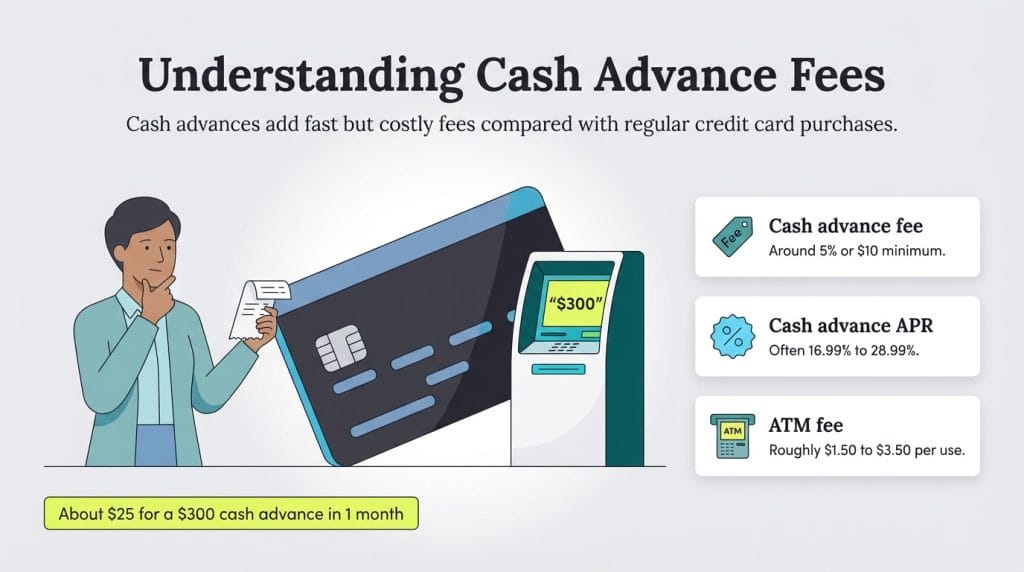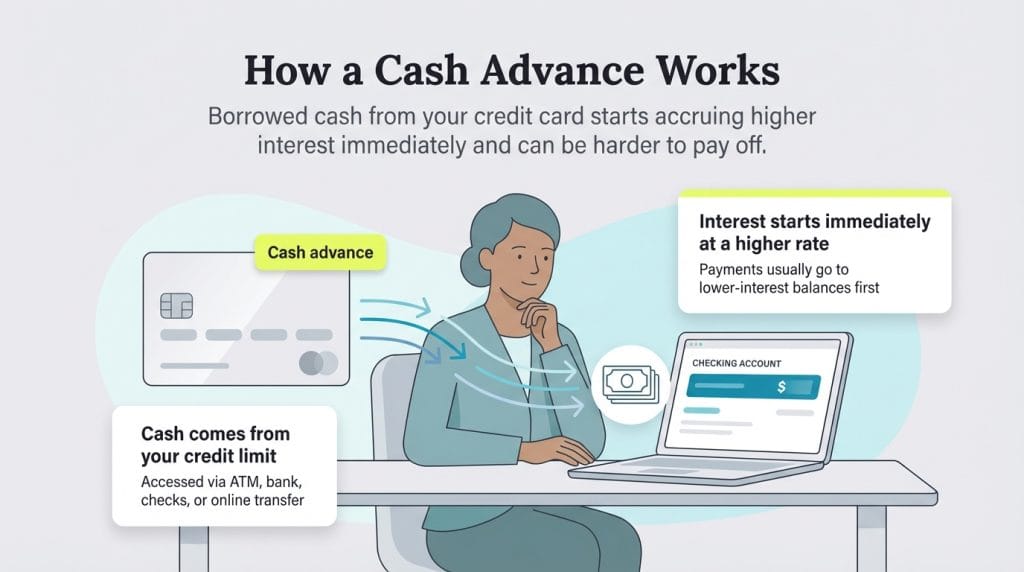Business.com aims to help business owners make informed decisions to support and grow their companies. We research and recommend products and services suitable for various business types, investing thousands of hours each year in this process.
As a business, we need to generate revenue to sustain our content. We have financial relationships with some companies we cover, earning commissions when readers purchase from our partners or share information about their needs. These relationships do not dictate our advice and recommendations. Our editorial team independently evaluates and recommends products and services based on their research and expertise. Learn more about our process and partners here.
What Are Cash Advances and How Do They Work?
Learn when to consider a cash advance and when it’s a bad idea.

Table of Contents
If you’ve ever needed cash quickly, you know the pressure and stress it can cause. Nobody likes having bills they can’t cover, so many businesses turn to a type of financing known as a cash advance. These short-term loans don’t usually require a lengthy application or credit check. They may seem like a quick fix, but cash advances aren’t always a wise choice. In many cases, they can make an already difficult financial situation worse.
So how do you know when a cash advance makes sense and when it’s better to look for another option? We’ll break down how cash advances work, along with their pros and cons, to help you make an informed financing decision for your business.
Editor’s note: Looking for a small business loan? Fill out the questionnaire below to have our vendor partners contact you about your needs.
What is a cash advance?

A cash advance is a short-term loan that lets you borrow against your credit card’s available limit. You can get the cash at an ATM, through a bank branch or via an online transfer. Not all business credit cards allow cash advances, but many small business owners use them to cover payroll or handle financial emergencies.
“A cash advance is basically where you borrow money from your credit card and pay a pretty exorbitant interest rate upon repayment,” explained Andrew Schrage, co-founder and CEO of Money Crashers.
Cash advances are one of the most expensive ways to borrow. They typically carry higher interest rates than standard credit card purchases — often 25 percent or more — plus additional fees. Because of these costs, a cash advance should only be used in emergencies and when you can pay the balance back quickly.
Merchant cash advances vs. credit card cash advances
While credit card cash advances let you borrow against your card’s limit, a merchant cash advance (MCA) works differently. With an MCA, your business gets a lump-sum payment in exchange for a percentage of future sales.
Unlike credit card cash advances, which charge fixed interest rates, MCAs use a factor rate system. For example, if you receive a $10,000 advance with a factor rate of 1.4, you’ll owe $14,000 in total. Repayment is usually automated, with the MCA provider deducting a set percentage of your daily credit card sales (often 5 to 20 percent) until the balance is paid off.
How does a cash advance work?

A cash advance works by letting you borrow cash against your credit card limit. You can access this cash in several ways:
- In person: Bring your credit card to your bank and request a cash advance.
- At an ATM: Enter your PIN and withdraw cash (ATMs may cap the amount you can take out). If you don’t have a PIN, request one from your card issuer.
- Convenience checks: Some cards offer checks that you can write to yourself and then cash or deposit.
- Online transfers: Many issuers let you transfer funds directly to your business checking account from their online portals.
Like any loan, you must repay your cash advance. However, repayment works differently from regular credit card purchases. There’s no grace period — interest starts the moment you take the cash, usually at a higher APR than your standard rate. The advance simply appears on your next credit card statement and is due with your regular monthly payment. But here’s the catch: card issuers usually apply your payment to lower-interest purchases first, so the cash advance balance (with its higher rate) can stick around longer and cost you more.
Fees also apply, either as a flat amount per transaction or as a percentage of what you borrow. Some issuers deduct the fee upfront, while others add it to your bill later.
What are the fees for cash advances?
Cash advances are easy to get, but that convenience comes with steep costs. On top of higher interest rates than regular purchases, you’ll likely face extra fees every time you use this feature.
Here are the most common ones:
- Cash advance fee: Typically 5 percent of the amount withdrawn, or a $10 minimum.
- Cash advance APR: Usually 16.99 percent to 28.99 percent, which is higher than your standard purchase APR.
- ATM fees: If you take out cash at an ATM, you may pay an additional $1.50 to $3.50 per transaction.
To put that into perspective, if you take a $300 cash advance with a 28.99 percent APR, a $15 fee and a $3.50 ATM charge, your one-month cost would be about $25. And if you don’t pay it off right away, interest keeps adding up each month.
What are the pros and cons of cash advances?
Cash advances have upsides and downsides. Here’s a closer look:
Pros of cash advances
- Easy to access: A cash advance is one of the simplest forms of financing. “The only real requirement … is that the credit card with which you are requesting one offers cash advances,” Schrage explained. There’s typically no credit check required.
- Fast funding: You don’t have to wait days for approval; the money is usually available immediately. That kind of speed can be a lifesaver in a pinch, and even the fastest business loans usually can’t match it.
- No spending restrictions: Unlike some business loans, you can use the funds however you need, whether it’s to process payroll, fill a cash flow gap or fund growth.
Cons of cash advances
- High fees and steep interest: Fees for cash advances can be exorbitant. “Your issuer will charge a cash advance fee, which is typically 3 percent to 5 percent of the transaction, with a minimum of $10,” explained Kevin Chen, credit card expert at Finder.com. “Even more dangerous, perhaps, is the steep interest rate you’ll pay … it’s very common for cash advance APRs to be above 25 percent.” On top of that, there’s no grace period; interest starts the day you take the advance.
- Payments apply last: Even if you make a big payment, your cash advance balance may not shrink right away. For example, if you already owe $500 and take a $100 cash advance, your payment will go toward the $500 balance first. The $100 advance sits untouched, racking up interest.
- Better alternatives exist: Experts generally recommend avoiding cash advances unless you have no other choice. “Your best bet is to avoid needing a cash advance at all costs,” Schrage advised. Instead, borrowing from a friend or family member, or taking out a personal loan, is usually far less expensive.
- Potential hit to your credit score: Cash advances don’t require a credit check, but they raise your credit utilization — a key factor in your score. Experts recommend keeping utilization under 30 percent, and using too much of your limit can drag your score down. “The dangers of a cash advance usually involve revolving utilization debt … it often
What are the alternatives to cash advances?
Because cash advances come with high costs and risks, it’s smart to explore other financing options first. The Small Business Administration suggests comparing different types of loans and credit to see what makes sense for your situation.
Here’s a quick look at some common alternatives:
Financing type | Interest rate | Approval time | Qualification requirements | Repayment terms |
|---|---|---|---|---|
Cash advance | 25-30 percent-plus APR | Same day | Credit card required | Immediate, high fees |
SBA loans | Typically 10-12 percent APR | 30-90 days | Good credit (670+), 2+ years in business | 5-25 years |
Term loans | 6-36 percent APR | 2-30 days | Good credit, business history | 1-7 years |
Business line of credit | 8-25 percent APR | 1-7 days | Established revenue | Revolving |
Invoice factoring | 1-5 percent per month | About 1 week | Outstanding invoices | 30-90 days |
While these financing options are typical alternatives to cash advances, don’t forget about simpler options too:
- Emergency fund: If you’ve built one, dipping into savings is far cheaper than a cash advance.
- Sell assets: Consider selling items you no longer need — from jewelry and electronics to even a second car or bike.
- Ask family or friends: Borrowing from trusted people can provide short-term relief without high-interest debt, though you’ll want to be upfront about repayment.
- Use your credit card: Charging an expense directly is usually less expensive than taking a cash advance.
Warning signs of predatory cash advance providers
Credit card cash advances from your issuer have clearly disclosed terms, but other types of cash advances — especially some merchant cash advances — have drawn scrutiny for unfair practices. The Consumer Financial Protection Bureau has established rules requiring clear disclosure of terms for business credit products, and the Federal Trade Commission has taken action against companies that use deceptive practices in merchant cash advance marketing.
Here are a few red flags to watch for in any lending situation:
- High-pressure sales tactics: Pushing you to sign quickly or discouraging comparison shopping.
- Hidden or excessive fees: Costs buried in the fine print or far higher than market rates.
- “Guaranteed approval” claims: Promises of funding regardless of credit or revenue.
- Changing terms: One set of conditions offered verbally, another in the contract.
- Unsolicited offers: Random calls or emails promising fast funding.
And here are a few signs that you’re dealing with a reputable provider:
- Licensed and compliant in your state.
- Transparent disclosures of all fees and repayment terms.
- Established reputation with reviews, references and Better Business Bureau ratings.
- Professional communication without scare tactics or urgency.
- Complete documentation and contracts provided up front.
When should you use a cash advance?
Cash advances are expensive, so they should only be a last resort. Here are a few things to think about before you decide:
Can your cash flow handle it?
Ask yourself:
- Do I have consistent revenue to cover the extra payments a cash advance would entail?
- Will this add too much strain to my existing debt load?
- How quickly can I realistically pay the cash advance back?
What’s the money for?
A cash advance should be reserved for true emergencies, such as repairing essential equipment, buying critical inventory or covering payroll in a pinch. It’s not a smart solution for long-term projects, paying down other debt or discretionary spending.
Cash advances as a last resort
Cash advances are costly and can quickly lead to a cycle of high-interest debt. In most cases, avoiding them is the smartest move. But if you’re facing a true emergency and don’t have another fast option, a cash advance can bridge the gap — as long as you’re confident you can repay it quickly.
Remember, debt should be a tool you use strategically, not something you rely on to stay afloat. If you find yourself depending on high-interest financing just to keep the lights on, it may be worth stepping back to reassess your business model and explore more sustainable ways to move forward.
Cash advance FAQs
- A $50 cash advance fee (5 percent of the amount)
- A $3 ATM fee
- About $148 in interest if your APR is 28 percent and you repay it over six months






